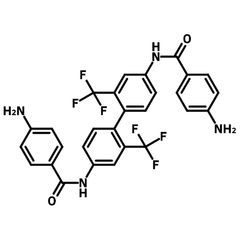AB-TFMB
CAS Number 1449757-11-2
Chemistry Building Blocks, COF Ligands, Diamines and Dianhydrides, Fluorinated Building Blocks,A fluorinated biphenyl diamine
As an intermediate for polyimides synthesis in application of high-performance polymers, flexible displays, and gas permeable membranes
Specifications | MSDS | Literature and Reviews
N,N'-(2,2'-bis(trifluoromethyl)-[1,1'-biphenyl]-4,4'-diyl)bis(4-aminobenzamide), CAS number 1449757-11-2, commonly known as AB-TFMB, has two anilines connecting to a trifluoromethyl biphenyl core through two carboxamides. AB-TFMB is used to synthesize polyimides with high transparency and low linear coefficient of thermal expansion (CTE) which are ideal for flexible displays. The transparency is brought by the trifluoromethyl substituents hindering the intermolecular charge transfer. The low CTE (4.2 ppm/K) is achieved by the linear and rigid structure of AB-TFMB.
The AB-TFMB based polyimides are also gas permeable with O2-transmission rate up to 2313 cm3/m2/day at 23 °C and 1.01 bar.
Multiple functional groups
For facile synthesis
Fluorinated diamine building block
For drug discovery, COFs, and polyamides
Worldwide shipping
Quick and reliable shipping
High purity
>99% High purity
General Information
| CAS Number | 1449757-11-2 |
| Chemical Formula | C28H20F6N4O2 |
| Full Name | N,N'-(2,2'-bis(trifluoromethyl)-[1,1'-biphenyl]-4,4'-diyl)bis(4-aminobenzamide) |
| Molecular Weight | 558.47 g/mol |
| Synonyms | N/A |
| Classification / Family | Fluorinated building block, Diamine building block, High performance polymers, Displays, Membranes |
Chemical Structure

Product Details
| Purity | >99% |
| Melting Point | Not Known |
| Appearance | White powder/crystal |
MSDS Documentation
Literature and Reviews
-
Colorless and transparent copolyimides and their nanocomposites: thermo-optical properties, morphologies, and gas permeabilities, H. Shin et al., Polymers, 11, 585(2019); DOI: 10.3390/polym11040585.
-
Development of solution-processable, optically transparent polyimides with ultra-low linear coefficients of thermal expansion, M. Hasegawa, Polymers, 9, 520(2017); DOI: 10.3390/polym9100520.
-
Low-CTE polyimides derived from 2,3,6,7-naphthalenetetracarboxylic dianhydride, M. Hasegawa et al., Polym. J., 39(6), 610-621(2007); DOI: 10.1295/polymj.PJ2006234.
